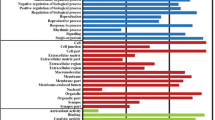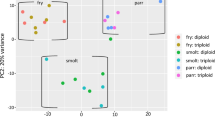Abstract
Focusing on adaptation of aquatic organisms, especially fish, can help elucidate complex dynamics in freshwater ecology. The differences in genetic and epigenetic regulation between diploid and triploid Carassius auratus affect survival under eutrophication. To identify the underlying mechanisms that lead to better adaption of triploids than diploids, we compared mRNA and microRNA (miRNA) expressions in liver tissue of diploid and triploid individuals obtained from the Dongting lake water system in central China. Differential expression analysis revealed that 566 transcripts were significantly up-regulated, whereas 758 were down-regulated in triploids; of these differentially expressed transcripts, 33 transcripts including cacna1d, nfkb2, hspa1 and fgfr4 were involved in the MAPK signaling pathway, and eight transcripts were determined to be regulated by seven miRNAs. Additionally, four of 25 differential expressed (DE) transcripts (mhc1, irf7, nfkb2 and pik3c) involving the viral carcinogenesis pathway were regulated by four miRNAs. Furthermore, genetic polymorphisms analysis showed that more heterozygous mutations were detected in triploids than diploids. The dN/dS results revealed that 21 genes were under positive selection (dN/dS>1) in C. auratus complex. We hypothesize that these changes related to genetic and epigenetic regulation may be caused by abiotic stresses, and facilitate adaptation to environmental changes.
Similar content being viewed by others
References
Allenjr, S.K., and Stanley, J.G. (1983). Ploidy of hybrid grass carp×bighead carp determined by flow cytometry. Trans Am Fisheries Soc 112, 431–435.
Ambros, V. (2004). The functions of animal microRNAs. Nature 431, 350–355.
Arai, K., and Wilkins, N.P. (1987). Triploidization of brown trout (Salmo trutta) by heat shocks. Aquaculture 64, 97–103.
Arkhipchuk, V.V., and Garanko, N.N. (2005). Using the nucleolar biomarker and the micronucleus test on in vivo fish fin cells. Ecotoxicol Environ Saf 62, 42–52.
Asahida, T., Kobayashi, T., Saitoh, K., and Nakayama, I. (1996). Tissue preservation and total DNA extraction form fish stored at ambient temperature using buffers containing high concentration of urea. Fisheries Sci 62, 727–730.
Benfey, T.J., and Biron, M. (2000). Acute stress response in triploid rainbow trout (Oncorhynchus mykiss) and brook trout (Salvelinus fontinalis). Aquaculture 184, 167–176.
Blanc, G., and Wolfe, K.H. (2004). Widespread paleopolyploidy in model plant species inferred from age distributions of duplicate genes. Plant Cell 16, 1667–1678.
Bonar, S.A., Thomas, G.L., and Pauley, G.B. (2010). Evaluation of the separation of triploid and diploid grass carp, Ctenopharyngodon idella (Valenciennes), by external morphology. J Fish Biol 33, 895–898.
Chen, R.E., and Thorner, J. (2007). Function and regulation in MAPK signaling pathways: lessons learned from the yeast Saccharomyces cerevisiae. Biochim Biophys Acta 1773, 1311–1340.
Chen, S., Wang, J., Liu, S.J., Qin, Q.B., Xiao, J., Duan, W., Luo, K.K., Liu, J.H., and Liu, Y. (2009). Biological characteristics of an improved triploid crucian carp. Sci China Ser C 52, 733–738.
Chen, Y., Williams, V., Filippova, M., Filippov, V., and Duerksen-Hughes, P. (2014). Viral carcinogenesis: factors inducing DNA damage and virus integration. Cancers 6, 2155–2186.
Cingolani, P., Platts, A., Wang, L.L., Coon, M., Nguyen, T., Wang, L., Land, S.J., Lu, X., and Ruden, D.M. (2012). A program for annotating and predicting the effects of single nucleotide polymorphisms, SnpEff. Fly 6, 80–92.
Creighton, C.J., Benham, A.L., Zhu, H., Khan, M.F., Reid, J.G., Nagaraja, A.K., Fountain, M.D., Dziadek, O., Han, D., Ma, L., et al. (2010). Discovery of novel microRNAs in female reproductive tract using next generation sequencing. PLoS ONE 5, e9637.
Duan, Y., Huang, S., Yang, J., Niu, P., Gong, Z., Liu, X., Xin, L., Currie, R. W., and Wu, T. (2014). HspA1A facilitates DNA repair in human bronchial epithelial cells exposed to Benzo[a]pyrene and interacts with casein kinase 2. Cell Stress Chaperones 19, 271–279.
Enright, A.J., John, B., Gaul, U., Tuschl, T., Sander, C., and Marks, D.S. (2003). microRNA targets in Drosophila. Genome Biol 5, R1.
Grabherr, M.G., Haas, B.J., Yassour, M., Levin, J.Z., Thompson, D.A., Amit, I., Adiconis, X., Fan, L., Raychowdhury, R., Zeng, Q., et al. (2011). Full-length transcriptome assembly from RNA-Seq data without a reference genome. Nat Biotechnol 29, 644–652.
Hochholdinger, F., and Hoecker, N. (2007). Towards the molecular basis of heterosis. Trends Plant Sci 12, 427–432.
Jin, J., Wang, Y., Wu, Z., Hergazy, A., Lan, J., Zhao, L., Liu, X., Chen, N., and Lin, L. (2017). Transcriptomic analysis of liver from grass carp (Ctenopharyngodon idellus) exposed to high environmental ammonia reveals the activation of antioxidant and apoptosis pathways. Fish Shellfish Immunol 63, 444–451.
John, B., Enright, A.J., Aravin, A., Tuschl, T., Sander, C., and Marks, D.S. (2004). Human microRNA targets. PLoS Biol 2, e363.
Johnston, I.A., Strugnell, G., Mccracken, M.L., and Johnstone, R. (1999). Muscle growth and development in normal-sex-ratio and all-female diploid and triploid Atlantic salmon. J Exp Biol 202, 1991–2016.
Kohl, M., Wiese, S., and Warscheid, B. (2011). Cytoscape: software for visualization and analysis of biological networks. Methods Mol Biol 696, 291–303.
Lee, S.I., Nguyen, X.T., Kim, J.H., and Kim, N.S. (2016). Genetic diversity and structure analyses on the natural populations of diploids and triploids of tiger lily, Lilium lancifolium Thunb., from Korea, China, and Japan. Genes Genom 38, 467–477.
Li, H., and Durbin, R. (2009). Fast and Accurate Short Read Alignment with Burrows-Wheeler Transform. (Oxford: Oxford University Press).
Li, H., Handsaker, B., Wysoker, A., Fennell, T., Ruan, J., Homer, N., Marth, G., Abecasis, G., Durbin, R., and Durbin, R. (2009). The sequence alignment/map format and SAMtools. Bioinformatics 25, 2078–2079.
Li, K.B. (2003). ClustalW-MPI: ClustalW analysis using distributed and parallel computing. Bioinformatics 19, 1585–1586.
Li, L., Stoeckert, C.J., and Roos, D.S. (2003). OrthoMCL: identification of ortholog groups for eukaryotic genomes. Genome Res 13, 2178–2189.
Liu, X.L., Jiang, F.F., Wang, Z.W., Li, X.Y., Li, Z., Zhang, X.J., Chen, F., Mao, J.F., Zhou, L., and Gui, J.F. (2017). Wider geographic distribution and higher diversity of hexaploids than tetraploids in Carassius species complex reveal recurrent polyploidy effects on adaptive evolution. Sci Rep 7, 5395.
Livak, K.J., and Schmittgen, T.D. (2001). Analysis of relative gene expression data using real-time quantitative PCR and the \(2^{-\Delta\Delta{C}_T}\) method. Methods 25, 402–408.
Lu, P., Su, Y., Niu, Z., and Wu, J. (2007). Geostatistical analysis and risk assessment on soil total nitrogen and total soil phosphorus in the Dongting Lake plain area, China. J Environ Qual 36, 935.
Luo, J., Gao, Y., Ma, W., Bi, X., Wang, S., Wang, J., Wang, Y., Chai, J., Du, R., Wu, S., et al. (2014). Tempo and mode of recurrent polyploidization in the Carassius auratus species complex (Cypriniformes, Cyprinidae). Heredity 112, 415–427.
Marie, V., Gonzalez, P., Baudrimont, M., Boutet, I., Moraga, D., Bourdineaud, J.P., and Boudou, A. (2006). Metallothionein gene expression and protein levels in triploid and diploid oysters Crassostrea gigas after exposure to cadmium and zinc. Environ Toxicol Chem 25, 412.
Mayer, M.P., and Bukau, B. (2005). Hsp70 chaperones: cellular functions and molecular mechanism. Cell Mol Life Sci 62, 670–684.
Mortazavi, A., Williams, B.A., McCue, K., Schaeffer, L., and Wold, B. (2008). Mapping and quantifying mammalian transcriptomes by RNASeq. Nat Methods 5, 621–628.
Qin, Q., Wang, J., Hu, M., Huang, S., and Liu, S. (2016). Autotriploid origin of Carassius auratus as revealed by chromosomal locus analysis. Sci China Life Sci 59, 622–626.
Oita, R.C., Mazzatti, D.J., Lim, F.L., Powell, J.R., and Merry, B.J. (2009). Whole-genome microarray analysis identifies up-regulation of Nr4a nuclear receptors in muscle and liver from diet-restricted rats. Mech Ageing Dev 130, 240–247.
Ojolick, E.J., Cusack, R., Benfey, T.J., and Kerr, S.R. (1995). Survival and growth of all-female diploid and triploid rainbow trout (Oncorhynchus mykiss) reared at chronic high temperature. Aquaculture 131, 177–187.
Quinlan, A.R., and Hall, I.M. (2010). BEDTools: a flexible suite of utilities for comparing genomic features. Bioinformatics 26, 841–842.
Ravi, V., and Venkatesh, B. (2008). Rapidly evolving fish genomes and teleost diversity. Curr Opin Genet Dev 18, 544–550.
Samuels, Y., Diaz Jr., L.A., Schmidt-Kittler, O., Cummins, J.M., DeLong, L., Cheong, I., Rago, C., Huso, D.L., Lengauer, C., Kinzler, K.W., et al. (2005). Mutant PIK3CA promotes cell growth and invasion of human cancer cells. Cancer Cell 7, 561–573.
Shayesteh, L., Lu, Y., Kuo, W.L., Baldocchi, R., Godfrey, T., Collins, C., Pinkel, D., Powell, B., Mills, G.B., and Gray, J.W. (1999). PIK3CA is implicated as an oncogene in ovarian cancer. Nat Genet 21, 99–102.
Stanley, J.G., Hidu, H., and Allen Jr., S.K. (1984). Growth of American oysters increased by polyploidy induced by blocking meiosis I but not meiosis II. Aquaculture 37, 147–155.
Sumpter, J.P., Lincoln, R.F., Bye, V.J., Carrgher, J.F., and Le Bail, P.Y. (1991). Plasma growth hormone levels during sexual maturation in diploid and triploid rainbow trout (Oncorhynchus mykiss). General Comp Endocrinol 83, 103–110.
Swarup, H. (1956). Production of heteroploidy in the three-spined stickleback, Gasterosteus aculeatus (L.). Nature 178, 1124–1125.
Swarup, H. (1959). Production of triploidy in Gasterosteus aculeatus (L). J Genet 56, 129–142.
Tiwary, B.K., Kirubagaran, R., and Ray, A.K. (2004). The biology of triploid fish. Rev Fish Biol Fisheries 14, 391–402.
Trapnell, C., Roberts, A., Goff, L., Pertea, G., Kim, D., Kelley, D.R., Pimentel, H., Salzberg, S.L., Rinn, J.L., and Pachter, L. (2012). Differential gene and transcript expression analysis of RNA-seq experiments with TopHat and Cufflinks. Nat Protoc 7, 562–578.
Wang, L., Feng, Z., Wang, X., Wang, X., and Zhang, X. (2010). DEGseq: an R package for identifying differentially expressed genes from RNAseq data. Bioinformatics 26, 136–138.
Wang, Y., Jiang, X., Li, Y.F., Wang, S.H., Wang, W.W., and Cheng, G.L. (2014). Spatial and temporal distribution of nitrogen and phosphorus and nutritional characteristics of water in Dongting Lake. Res Environ Sci 27, 484–491.
White, M.J.D. (1970). Heterozygosity and Genetic Polymorphism in Parthenogenetic Animals. (New York: Springer).
Wolters, W.R., Chrisman, C.L., and Libey, G.S. (1982). Erythrocyte nuclear measurements of diploid and triploid channel catfish, Ictalurus punctatus (Rafinesque). J Fish Biol 20, 253–258.
Xiao, J., Zou, T., Chen, Y., Chen, L., Liu, S., Tao, M., Zhang, C., Zhao, R., Zhou, Y., Long, Y., et al. (2011). Coexistence of diploid, triploid and tetraploid crucian carp (Carassius auratus) in natural waters. BMC Genet 12, 20.
Yao, H., Dogra Gray, A., Auger, D.L., and Birchler, J.A. (2013). Genomic dosage effects on heterosis in triploid maize. Proc Natl Acad Sci USA 110, 2665–2669.
Ye, Y.W., Zhou, Y., Yuan, L., Wang, C.M., Du, C.Y., Zhou, X.Y., Zheng, B. Q., Cao, X., Sun, M.H., Fu, H., et al. (2011). Fibroblast growth factor receptor 4 regulates proliferation and antiapoptosis during gastric cancer progression. Cancer 117, 5304–5313.
Yoshida, M., Nagamine, M., and Uematsu, K. (2005). Comparison of behavioral responses to a novel environment between three teleosts, bluegill Lepomis macrochirus, crucian carp Carassius langsdorfii, and goldfish Carassius auratus. Fisheries Sci 71, 314–319.
Zhang, Z., Li, J., Zhao, X Q., Wang, J., Wong, K.S., and Yu, J. (2006). KaKs_Calculator: calculating Ka and Ks through model selection and model averaging. GPB 4, 259–263.
Zhu, X., Zhu, L., Lang, Y., and Chen, Y. (2008). Oxidative stress and growth inhibition in the freshwater fish Carassius auratus induced by chronic exposure to sublethal fullerene aggregates. Environ Toxicol Chem 27, 1979–1985.
Acknowledgements
This work was supported by the National Natural Science Foundation of China (317023343, 1430088, 31730098), the earmarked fund for China Agriculture Research System (CARS-45), the Key Research and Development Project of Hunan Province (2016NK2128), the Key Research and Development Project of Hunan Province (2016NK2128), Hunan Provincial Natural Science and Technology Major Project (2017NK1031), the Cooperative Innovation Center of Engineering and New Products for Developmental Biology of Hunan Province (20134486), the Construction Project of Key Discipline of Hunan Province and China, Natural Science Foundation of Hunan Province (14JJ2148) and the Scientific Research Fund of Hunan Provincial Education Department (16C0974).
Author information
Authors and Affiliations
Corresponding author
Electronic supplementary material
Rights and permissions
About this article
Cite this article
Ren, L., Gao, X., Yang, C. et al. Comparison of diploid and triploid Carassius auratus provides insights into adaptation to environmental change. Sci. China Life Sci. 61, 1407–1419 (2018). https://doi.org/10.1007/s11427-017-9358-7
Received:
Accepted:
Published:
Issue Date:
DOI: https://doi.org/10.1007/s11427-017-9358-7








